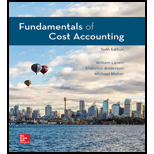
Fundamentals of Cost Accounting
6th Edition
ISBN: 9781260708783
Author: LANEN, William
Publisher: MCGRAW-HILL HIGHER EDUCATION
expand_more
expand_more
format_list_bulleted
Question
Chapter 14, Problem 21CADQ
To determine
Comment on the given statement.
Expert Solution & Answer
Want to see the full answer?
Check out a sample textbook solution
Students have asked these similar questions
Accurate Answer
I am searching for the correct answer to this general accounting problem with proper accounting rules.
I am looking for the correct answer to this general accounting question with appropriate explanations.
Chapter 14 Solutions
Fundamentals of Cost Accounting
Ch. 14 - What are the advantages of divisional income as a...Ch. 14 - How is divisional income like income computed for...Ch. 14 - How is return on investment (ROI) computed?Ch. 14 - What are the advantages of using an ROI-type...Ch. 14 - How can ratios, such as ROI, be used for control...Ch. 14 - How does residual income differ from ROI?Ch. 14 - How does EVA differ from residual income?Ch. 14 - What impact does the use of gross book value or...Ch. 14 - What are the dangers of using only business unit...Ch. 14 - A company prepares the master budget by taking...
Ch. 14 - Prob. 11CADQCh. 14 - What problems might there be if the same methods...Ch. 14 - Prob. 13CADQCh. 14 - The chapter identified some problems with ROI-type...Ch. 14 - Failure to invest in projects is not a problem...Ch. 14 - How would you respond to the following comment?...Ch. 14 - Prob. 17CADQCh. 14 - Prob. 18CADQCh. 14 - Prob. 19CADQCh. 14 - Prob. 20CADQCh. 14 - Prob. 21CADQCh. 14 - Compute Divisional Income Arlington Clothing,...Ch. 14 - Compute Divisional Income Refer to Exercise 14-22....Ch. 14 - Computing Divisional Income: Incomplete...Ch. 14 - Compute RI and ROI The Campus Division of...Ch. 14 - Prob. 26ECh. 14 - Compare Alternative Measures of Division...Ch. 14 - Comparing Business Units Using ROI Back Mountain...Ch. 14 - Comparing Business Units Using Residual Income...Ch. 14 - Prob. 30ECh. 14 - Universal Electronics, Inc. (UEI), which started...Ch. 14 - Comparing Business Units Using Residual...Ch. 14 - Comparing Business Units Using Economic Value...Ch. 14 - Impact of New Asset on Performance Measures The...Ch. 14 - Refer to the data in Exercise 14–34. The division...Ch. 14 - Refer to the information in Exercises 14–34 and...Ch. 14 - Impact of an Asset Disposal on Performance...Ch. 14 - Impact of an Asset Disposal on Performance...Ch. 14 - Compare Historical Cost, Net Book Value to Gross...Ch. 14 - Prob. 40ECh. 14 - Prob. 41ECh. 14 - Effects of Current Cost on Performance...Ch. 14 - Comparing Business Units Using Divisional Income,...Ch. 14 - Comparing Business Units Using Economic Value...Ch. 14 - Prob. 45PCh. 14 - Equipment Replacement and Performance Measures...Ch. 14 - Prob. 47PCh. 14 - Prob. 48PCh. 14 - Prob. 49PCh. 14 - Prob. 50PCh. 14 - Prob. 51PCh. 14 - Evaluate Performance Evaluation System: Behavioral...Ch. 14 - ROI, EVA, and Different Asset Bases Hys is a...Ch. 14 - Economic Value Added Bisbee Health Products...Ch. 14 - Prob. 55PCh. 14 - Prob. 56PCh. 14 - Refer to the information in Exercise 14-39. Assume...Ch. 14 - Refer to the information in Exercise 14-42. Assume...
Knowledge Booster
Similar questions
- I am searching for the accurate solution to this general accounting problem with the right approach.arrow_forwardI am looking for help with this general accounting question using proper accounting standards.arrow_forwardCan you help me solve this general accounting problem using the correct accounting process?arrow_forward
- Please provide the correct answer to this general accounting problem using valid calculations.arrow_forwardIn addition to your explanation, address the following self-reflection questions: How does the WH Framework help you analyze the situation? Now that I've put together the framework, how does the WH Framework help managers with making business decisions? And What type of decisions would the WH Framework chart help make as a manager?arrow_forwardPlease provide the accurate answer to this general accounting problem using valid techniques.arrow_forward
arrow_back_ios
SEE MORE QUESTIONS
arrow_forward_ios
Recommended textbooks for you
 Cornerstones of Cost Management (Cornerstones Ser...AccountingISBN:9781305970663Author:Don R. Hansen, Maryanne M. MowenPublisher:Cengage LearningBusiness/Professional Ethics Directors/Executives...AccountingISBN:9781337485913Author:BROOKSPublisher:Cengage
Cornerstones of Cost Management (Cornerstones Ser...AccountingISBN:9781305970663Author:Don R. Hansen, Maryanne M. MowenPublisher:Cengage LearningBusiness/Professional Ethics Directors/Executives...AccountingISBN:9781337485913Author:BROOKSPublisher:Cengage Managerial AccountingAccountingISBN:9781337912020Author:Carl Warren, Ph.d. Cma William B. TaylerPublisher:South-Western College Pub
Managerial AccountingAccountingISBN:9781337912020Author:Carl Warren, Ph.d. Cma William B. TaylerPublisher:South-Western College Pub Financial And Managerial AccountingAccountingISBN:9781337902663Author:WARREN, Carl S.Publisher:Cengage Learning,
Financial And Managerial AccountingAccountingISBN:9781337902663Author:WARREN, Carl S.Publisher:Cengage Learning, Intermediate Financial Management (MindTap Course...FinanceISBN:9781337395083Author:Eugene F. Brigham, Phillip R. DavesPublisher:Cengage LearningPrinciples of Accounting Volume 2AccountingISBN:9781947172609Author:OpenStaxPublisher:OpenStax College
Intermediate Financial Management (MindTap Course...FinanceISBN:9781337395083Author:Eugene F. Brigham, Phillip R. DavesPublisher:Cengage LearningPrinciples of Accounting Volume 2AccountingISBN:9781947172609Author:OpenStaxPublisher:OpenStax College

Cornerstones of Cost Management (Cornerstones Ser...
Accounting
ISBN:9781305970663
Author:Don R. Hansen, Maryanne M. Mowen
Publisher:Cengage Learning

Business/Professional Ethics Directors/Executives...
Accounting
ISBN:9781337485913
Author:BROOKS
Publisher:Cengage

Managerial Accounting
Accounting
ISBN:9781337912020
Author:Carl Warren, Ph.d. Cma William B. Tayler
Publisher:South-Western College Pub

Financial And Managerial Accounting
Accounting
ISBN:9781337902663
Author:WARREN, Carl S.
Publisher:Cengage Learning,

Intermediate Financial Management (MindTap Course...
Finance
ISBN:9781337395083
Author:Eugene F. Brigham, Phillip R. Daves
Publisher:Cengage Learning

Principles of Accounting Volume 2
Accounting
ISBN:9781947172609
Author:OpenStax
Publisher:OpenStax College